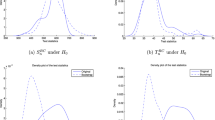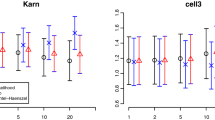Abstract
Cox's partial likelihood for censored time-to-event data can be interpreted as a permutation probability, whereby covariate values are permuted to the observed times-to-event and censoring times. This interpretation facilitates a simple method for jointly generating times-to-event and covariate tuples with considerable flexibility, including time dependence of the hazard ratio and specification of both the marginal time-to-event and covariate distributions. This interpretation also facilitates a method for semi-parametric bootstrapping of hazard ratio estimators.
Similar content being viewed by others
References
Abrahamowicz M., MacKenzie T., and Esdaile J.M. 1996. Time-dependent hazard ratio: Modeling and hypothesis testing with application in lupus nephritis. Journal of the American Statistical Association 91: 1432-1439.
Andersen P.K., Borgan O., Gill R.D., and Keiding N. 1993. Statistical Models Based on Counting Processes. Springer-Verlag, New York.
Cox D.R. 1972. Regression models and life tables (with discussion). Journal of the Royal Statistical Society B 34: 187-220.
Cox D.R. 1975. Partial likelihood. Biometrika 62: 269-276.
Devroye L. 1986. Non-Uniform Random Variate Generation. Springer-Verlag, New York.
Efron B. and Tibshirani R. 1993. An Introduction to the Bootstrap. Chapman and Hall, New York.
Gray R.J. 1992. Flexible methods for analyzing survival data using splines, with applications to breast cancer prognosis. Journal of the American Statistical Association 87: 942-951.
Hastie T.J. and Tibshirani R.J. 1993. Varying-coefficient models (with discussion). Journal of the The Royal Statistical Society, Set. B 55: 757-796.
Kooperberg C., Stone C.J., and Truong Y.K. 1995. Hazard regression. Journal of the American Statistical Association 90: 78-94.
Lewis P.A. and Shedler G.S. 1979. Simulation of nonhomogeneous Poisson processes by thinning. Naval Research Logistics Quarterly 26: 403-413.
MacKenzie T. 1997. The use of markers to enhance time-to-event analysis. Ph.D. Disseration, McGill University, Montreal.
Murray S. and Tsiatis A.A. 1996. Nonparametric survival estimation using prognostic longitudinal covariates. Biometrics 52: 137-151.
Robins J.M. and Rotnitsky A. 1992. Recovery of information and adjustment for dependent censoring using surrogate markers. In: Jewell N., Dietz K., and Farewell V. (Eds.), AIDS Epidemiology: Methodological Issues. Birkhauser-Boston, Boston, pp. 297-331.
Verweij P.J.M. and Houwelingen H.C. 1995. Time-dependent effects of fixed covariates in Cox regression. Biometrics 51: 1550-1556.
Zelterman D., Le C.T., and Louis T.A. 1996. Bootstrap techniques for proportional hazards models with censored observations. Statistics and Computing 6: 191-199.
Rights and permissions
About this article
Cite this article
Mackenzie, T., Abrahamowicz, M. Marginal and hazard ratio specific random data generation: Applications to semi-parametric bootstrapping. Statistics and Computing 12, 245–252 (2002). https://doi.org/10.1023/A:1020750810409
Issue Date:
DOI: https://doi.org/10.1023/A:1020750810409




